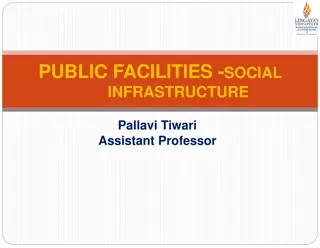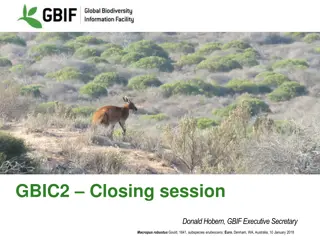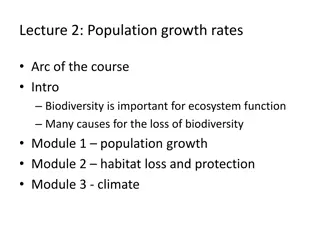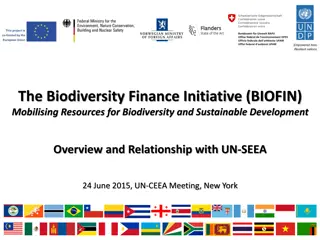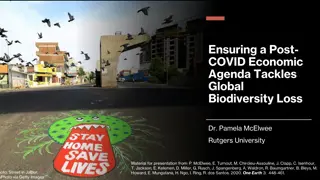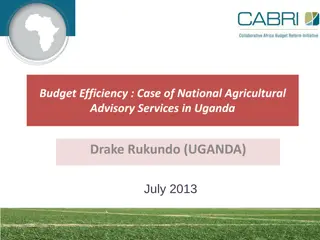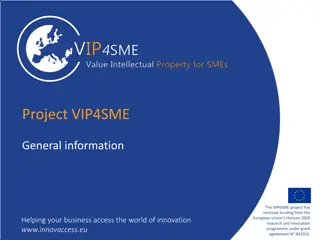Small-Scale Farmer Innovation and Agricultural Biodiversity in the Context of Intellectual Property
Discussions at the WIPO International Conference on IP and Innovation for Sustainable Agriculture highlighted the crucial role of small-scale farmers in managing and developing agricultural biodiversity, which is essential for sustainable agricultural production and global food security. The session emphasized the significance of farmers' innovative activities and the dynamic genetic diversity present in farmers' varieties and wild species related to domestic crops. It also touched upon the impact of intellectual property rights on agricultural technologies and crop improvement, emphasizing the need for a balance between individual rights and the broader social good in IP policy.
- Small-scale farmer innovation
- Agricultural biodiversity
- Intellectual property
- Sustainable agriculture
- Genetic diversity
Download Presentation

Please find below an Image/Link to download the presentation.
The content on the website is provided AS IS for your information and personal use only. It may not be sold, licensed, or shared on other websites without obtaining consent from the author. Download presentation by click this link. If you encounter any issues during the download, it is possible that the publisher has removed the file from their server.
E N D
Presentation Transcript
WIPO International Conference on IP and Innovation for Sustainable Agriculture April 24, 2023 Small-scale farmer innovation, agricultural biodiversity and intellectual property: exploring connections. Susan H. Bragdon Director, Seeds for All 8/9/2024 WIPO FOR OFFICIAL USE ONLY
Agricultural Innovation Discussions about agricultural innovation tend to neglect innovations by farmers themselves. The innovative activities of small-scale farmers in managing and developing agricultural biodiversity is critical to sustainable agricultural production and global food and nutrition security. 8/9/2024 WIPO FOR OFFICIAL USE ONLY
Small-scale farmers and agricultural biodiversity The majority of agricultural biodiversity is actively maintained, used and developed by small-scale farmers on-farm and in situ. Agricultural biodiversity is arguably the most valuable natural resource on earth. It is not a static resource and depends on the similarly dynamic innovation systems of small-scale farmers who have been conserving, managing and developing these resources for almost 12,000 years. Farmers varieties and wild species related to domestic crops are the dynamic pool of genetic diversity that farmers and the global community rely on for their resistance, tolerance and immunity to stresses. 8/9/2024 WIPO FOR OFFICIAL USE ONLY
Agriculture-related IP: Who and what is incentivized (& who and what are not) Advocates for IPR argue that the development and dissemination of appropriate agricultural technologies, including new plant varieties are essential to keep pace with the world s ever increasing food needs. They argue that such technologies depend on the investment incentives provided by IPR frameworks. See, https://www.wipo.int/publications/en/details.jsp?id=220 8/9/2024 WIPO FOR OFFICIAL USE ONLY
IP and Crop Improvement In general, IPR incentivizes investment in crop improvement where there is a likely return on investment correlating with profitable, large commercial markets. The premise is that innovators are driven by economic gain and IPR enables them to capture economic benefit from their investment. Investment in minor crops important to SSF or in the development of varieties suited to diverse and often marginal environments without the use of additional inputs is not profitable. 8/9/2024 WIPO FOR OFFICIAL USE ONLY
Expansion of global reach of IPR The adoption of the WTO TRIPS Agreement in 1994 and the 1991 revision of UPOV expanded the global scope of the recognition of plant-related IP that was occurring in industrialized countries. Reflects a push for the global harmonization and decreased flexibility in terms of developing national IP regimes. Concern that over the last several decades the trend is towards an expansion of the individual rights component of IP policy and a contraction on the focus on the broader social good. 8/9/2024 WIPO FOR OFFICIAL USE ONLY
From: 2009 Report of Special Rapporteur on Right to Food: Enhancing Agrobiodiversity and Encouraging Innovation Intellectual property rights reward and encourage standardization and homogeneity, when what should be rewarded is agrobiodiversity, particularly in the face of the emerging threat of climate change and the need, therefore, to build resilience by encouraging farmers to rely on a diversity of crops. https://www.ohchr.org/sites/default/files/HRBodies/HRC/RegularSessions/S ession25/Documents/A_HRC_25_57_ENG.DOC 8/9/2024 WIPO FOR OFFICIAL USE ONLY
Arguments that plant-related IPR has inhibited innovation and undermined welfare of SSF by: Encouraging the cultivation of a narrow range of genetically uniform crops at the expense of crop diversity; Limiting farmers ability to access and exchange seed; Restricting the circulation and traditional exchange of plant genetic resources; Constraining the ability to do follow-on R&D. 8/9/2024 See, Moretti UN Doc. UNCTAD/DITC/COM/2005/16 (2006) WIPO FOR OFFICIAL USE ONLY
Role of IPR in changes in agricultural systems worldwide Plays a role in the spread of a type of agriculture that emphasizes market-based and technological approaches; Technologies are developed externally to solve identified problems disaggregated from the larger system of which they are part and from where they emerge without regard to impact on SSF and agricultural biodiversity; Newer versions of the technology-fix/market solution approach e.g., gene-editing are part of this framework of discussion. 8/9/2024 WIPO FOR OFFICIAL USE ONLY
Strong tendency to reduce agricultural innovation to uptake of new technologies persists Obvious allure of technologies that solve a particular problem e.g., through the creation of drought-resistant or biofortified or saline-tolerant seeds. But we must evaluate technologies in terms impact on things like erosion of biodiversity, the displacement of SSF, synergies between food production and ecosystem function, the co-creation of knowledge, protecting rural livelihoods, creating path dependencies etc (See, HLPE 2019) Support for the uptake of externally created technologies risks reinforcement of the flow of financial investments, human resources, training and education to this narrow view of innovation without consideration of other possible negative impacts. 8/9/2024 WIPO FOR OFFICIAL USE ONLY
Global plant-related IP is a new experiment relative to 12,000 years of agriculture development Today s globalized food system of which the requirement for plant-related IP is a part has been around only a few decades. It is one component of a new experiment in incentivizing a particular type and approach to innovation. IP policy at best ignores and at worst disrupts the role that SSF and agricultural biodiversity play in feeding the world and adapting agriculture to increasing stressors, including climate change. 8/9/2024 WIPO FOR OFFICIAL USE ONLY
The way forward We need a broader conceptualization of what agricultural innovation means and who it is for. There are more forms of innovation than IPR typically addresses including SSF innovation. SSF must be central in conversations on agricultural innovation as the best tools to incentivize SSF and agricultural biodiversity are developed, and policy impediments are removed. Governments will need the flexibility and the resources to implement appropriate public policies. 8/9/2024 WIPO FOR OFFICIAL USE ONLY






